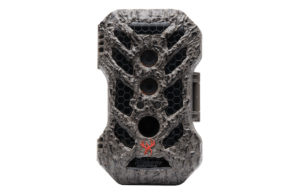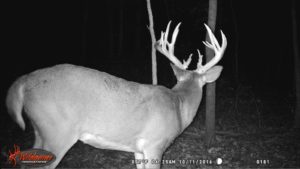Of all the scouting tools available today, perhaps none is as effective as the game camera. This device has changed the way we locate and hunt big bucks. However, simply buying one of these tools and strapping it to a tree guarantees nothing. There is many aspects to consider when employing a game camera.
If used strategically, a game camera could lead you to your next trophy. If deployed with little thought, it will become nothing more than another piece of hunting gear that didn’t live up to the hype. If your goal is to get the most out of your game camera’s capabilities, consider these details every time you strap it to a tree and walk away.
Faster Than A Speeding Bullet
In an effort to give customers the best product possible, manufacturers add new features to game cameras every year. And that’s a good thing! However, if there is a downside it would have to be that sometimes we end up paying for more technology than we actually need.
For example, while trigger speed is an enormous selling point for most units, a fast-acting camera isn’t necessarily for everyone, especially if you mainly hunt food plots. The reason is simple: The deer are going to be in pretty much the same spot for several minutes. If your camera will be positioned over a food plot, paying extra for a quick trigger speed is really a waste of money. The camera is going to get good images no matter what the trigger speed is.
On the other hand, a game camera set up along a trail would indeed need to react in a super-fast manner. Otherwise, all you will get is the south end of a north-bound deer. So consider where your camera will be stationed before paying extra for fast trigger speed. The odds are good you might not need it.

Tail cameras like the Silent Crush 20 Lightsout from Wildgame Innovations continue to become more sophisticated. This model features a glass lens optimized for superior HD quality, while the another lens is designed to take nighttime images with better clarity and illumination and decreased night blur.
Additional Options
Like trigger speed, there are a host of camera specifications that should be considered before you make a purchasing decision. Let’s quickly break down those that get the bulk of attention.
IR vs Regular Flash: This feature really comes down to whether or not you believe a standard white flash will spook a mature buck or not. In my opinion, until it is proven that a white flash does not spook whitetails, I am sticking with the no-flash (infrared) models that are undetectable to the eyes of a deer.
Battery Life: This is a big deal, especially if your camera is some distance away from home and you have to make long trips to retrieve it. Not only that, repeated trips into your hunting area to swap batteries will only educate the very buck you are chasing. Select a model with the longest battery life and the highest number count (images it can capture) you can afford.
Megapixels: Unless your images are intended for professional use, a high megapixel rating won’t exactly give you an advantage over a camera with a lower rating. Sure, the images may be clearer when zoomed, but that isn’t going to help you put the pieces of the puzzle together. Honestly, I believe megapixels are overrated.
The Right Setup
Without a doubt, you could have the best game camera on the market and still come up short in the “useful information” department. This is most often the result of several different factors. Let’s look at the most obvious: location.

Stamp it. Details such as time, date and moon phase can all help you put the pieces of the whitetail puzzle together and shouldn’t be overlooked.
When choosing a good spot in which to hang a camera, I typically gravitate to areas that offer food, bedding security or safe travel in between. I know that sounds elementary, but if you are just getting into the game camera/whitetail game then you may not be aware of the locations that can lead to a high number of images captured.
Finding the right spot for your game camera is only the first step in capturing useful images. Here’s a brief rundown on some other aspects to game camera setup you need to take into account.
Trails: When setting up your camera to cover a trail, be sure to place it at an angle. For example, don’t hang it looking straight at the trail from the side. Instead, turn it so that it looks up or down the trail. This will give your camera plenty of time to detect movement as the animal approaches (or as it walks away) rather than trying to get a snapshot as the buck walks quickly in and out of frame from the side.
Attractants: If your camera is in a good pinch point or funnel but you don’t expect the deer to naturally stop for any amount of time, you can always make them stop. How? Try using some food-based or breeding attractants. This can begin in early summer with salt and mineral supplements. You can also construct mock scrapes or use bait (where legal) to attract and hold mature bucks for longer periods of time.
Sun and Vegetation: Turning your camera so that it faces the sun will result in a lot of images with nothing in them. Game cameras are triggered by heat and movement. When your camera is facing the sun it will get several false heat signatures, especially if there is vegetation present and it is being moved by the wind.
Consider the Phase: During the early season a deer’s thoughts are dominated by food. Therefore, your camera setups should revolve around that as well. This will give you the highest overall chance of capturing deer movement.
Likewise, as the season progresses, so should your camera strategy. The pre-rut should find you monitoring rubs, scrapes and typical doe hangouts. The breeding phase should lead to cameras being set up in thick bedding cover and isolated places where bucks and does can be left alone to … well, you know. Hunting pressure can also make deer (as well as your camera) move into more secluded areas.
Control Your Odor: Don’t be fooled into thinking that just because you aren’t hunting that you don’t have to be as scent-free as possible. Nothing could be further from the truth. In fact, if you are targeting mature bucks (and who isn’t?), leaving behind odor when you hang your camera or swap SD cards will definitely lead to educating the very buck you’re trying to find.
Make sure you treat every trip to the woods as if you are hunting. This means showering beforehand, wearing scent-free clothes, and especially incorporating rubber boots and gloves. This all becomes even more imperative during the summer months when just thinking about hanging a game camera can make you sweat.
Retrieving Data: When it comes to game cameras, perhaps one of the biggest mistakes hunters make revolves around checking the camera. It’s easy to let the excitement of “what if” take over and force you into checking your camera for images just a little too often. And, just like leaving behind odor will do, repeated intrusions into your hunting area to check images can ruin your chances of success.
More than Antlers
As much as I like to see a good set of antlers I will often take more pleasure in knowing that I have scores of does passing in front of my camera. Why? Because sooner or later one of them is going to lead a buck past my stand. So don’t get too discouraged if your game cameras aren’t covered up with antlers. Knowing the whereabouts of a solid group of does will most often lead to success later on during the rut. Stay patient.
Stamp It
Many of today’s game cameras come with an information strip stamped on the bottom of each image. Details such as time, date and moon phase can all help you put the pieces of the whitetail puzzle together and shouldn’t be overlooked. Mature bucks are an odd lot, and when it comes to putting an arrow through one no detail should be left to chance.
That is a big reason why I use an aftermarket software program called DeerLab. DeerLab’s game camera software accurately tells me when and where to hunt, all while simplifying how I manage and share my game camera photos. This program can take thousands of images and break deer movement down into peak times based on wind direction/speed, time, date, weather, moon phase and much, much more. In fact, it’s too much to list here. Visit www.deerlab.com for more information.
Conclusion
Game cameras become more advanced every year and can greatly increase your odds of success. However, no matter how high-tech they may get, these low-tech strategies will always lead to the best overall performance.
Featured Photo: Wildgame Innovations






